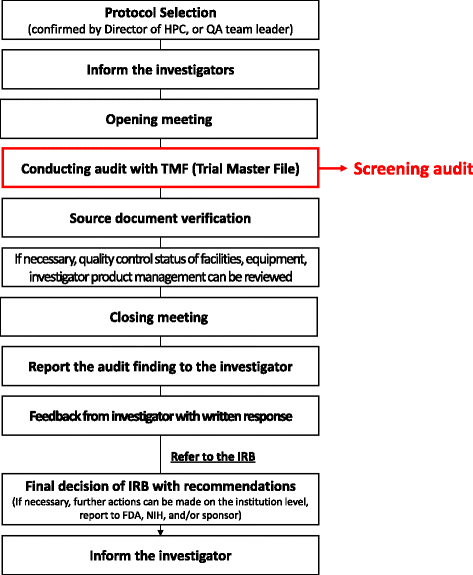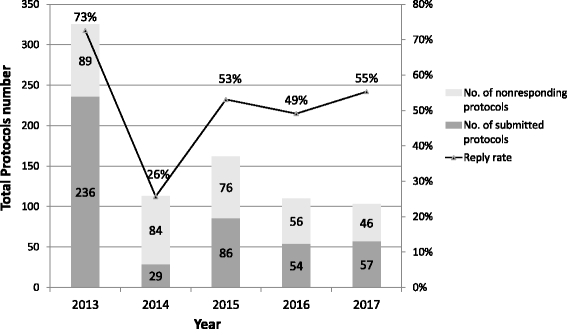'Screening audit' as a quality assurance tool in good clinical practice compliant research environments
- PMID: 29699559
- PMCID: PMC5922013
- DOI: 10.1186/s12910-018-0269-2
'Screening audit' as a quality assurance tool in good clinical practice compliant research environments
Abstract
Background: With the growing amount of clinical research, regulations and research ethics are becoming more stringent. This trend introduces a need for quality assurance measures for ensuring adherence to research ethics and human research protection beyond Institutional Review Board approval. Audits, one of the most effective tools for assessing quality assurance, are measures used to evaluate Good Clinical Practice (GCP) and protocol compliance in clinical research. However, they are laborious, time consuming, and require expertise. Therefore, we developed a simple auditing process (a screening audit) and evaluated its feasibility and effectiveness.
Methods: The screening audit was developed using a routine audit checklist based on the Severance Hospital's Human Research Protection Program policies and procedures. The measure includes 20 questions, and results are summarized in five categories of audit findings. We analyzed 462 studies that were reviewed by the Severance Hospital Human Research Protection Center between 2013 and 2017. We retrospectively analyzed research characteristics, reply rate, audit findings, associated factors and post-screening audit compliance, etc. RESULTS: Investigator reply rates gradually increased, except for the first year (73% → 26% → 53% → 49% → 55%). The studies were graded as "critical," "major," "minor," and "not a finding" (11.9, 39.0, 42.9, and 6.3%, respectively), based on findings and number of deficiencies. The auditors' decisions showed fair agreement with weighted kappa values of 0.316, 0.339, and 0.373. Low-risk level studies, single center studies, and non-phase clinical research showed more prevalent frequencies of being "major" or "critical" (p = 0.002, < 0.0001, < 0.0001, respectively). Inappropriateness of documents, failure to obtain informed consent, inappropriateness of informed consent process, and failure to protect participants' personal information were associated with higher audit grade (p < 0.0001, p = 0.0001, p < 0.0001, p = 0.003). We were able to observe critical GCP violations in the routine internal audit results of post-screening audit compliance checks in "non-responding" and "critical" studies upon applying the screening audit.
Conclusions: Our screening audit is a simple and effective way to assess overall GCP compliance by institutions and to ensure medical ethics. The tool also provides useful selection criteria for conducting routine audits.
Keywords: Clinical research; Quality assurance; Screening audit.
Conflict of interest statement
Ethics approval and consent to participate
Ethics approval and participant consent was not necessary as this study involved the use of an encrypted database and does not contain personal information or identifiers according to the Bioethics and Safety Act, Korea.
Competing interests
The authors declare that they have no competing interests.
Publisher’s Note
Springer Nature remains neutral with regard to jurisdictional claims in published maps and institutional affiliations.
Figures


Similar articles
-
American Society of Clinical Oncology policy statement: oversight of clinical research.J Clin Oncol. 2003 Jun 15;21(12):2377-86. doi: 10.1200/JCO.2003.04.026. Epub 2003 Apr 29. J Clin Oncol. 2003. PMID: 12721281
-
Audit of the informed consent process as a part of a clinical research quality assurance program.Sci Eng Ethics. 2014 Jun;20(2):469-79. doi: 10.1007/s11948-013-9461-4. Epub 2013 Aug 24. Sci Eng Ethics. 2014. PMID: 23975172
-
Research ethics committee auditing: the experience of a university hospital.HEC Forum. 2013 Sep;25(3):257-68. doi: 10.1007/s10730-013-9210-8. HEC Forum. 2013. PMID: 23435968
-
Review of national research ethics regulations and guidelines in Middle Eastern Arab countries.BMC Med Ethics. 2012 Dec 12;13:34. doi: 10.1186/1472-6939-13-34. BMC Med Ethics. 2012. PMID: 23234422 Free PMC article. Review.
-
Best practice & research in anaesthesiology issue on new approaches in clinical research ethics in clinical research.Best Pract Res Clin Anaesthesiol. 2011 Dec;25(4):569-82. doi: 10.1016/j.bpa.2011.08.003. Best Pract Res Clin Anaesthesiol. 2011. PMID: 22099922 Review.
References
-
- Guideline IH. Integrated addendum to ICH E6 (R1): guideline for good clinical practice E6 (R2). Current Step. 2015;2:1–60.
-
- Medicine Io . Contemporary issues for protecting patients in cancer research: workshop summary. Washington, DC: The National Academies Press; 2014. - PubMed
-
- Fleiss JL. Statistical methods for rates and proportions. New York: Wiley; 1981.
Publication types
MeSH terms
LinkOut - more resources
Full Text Sources
Other Literature Sources

